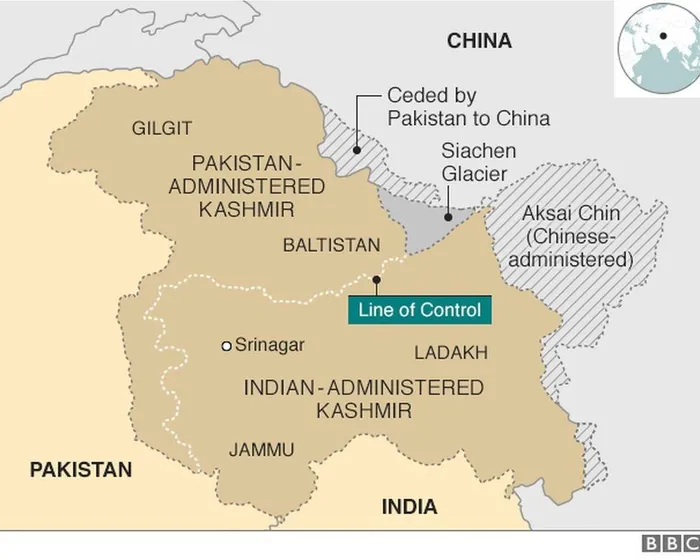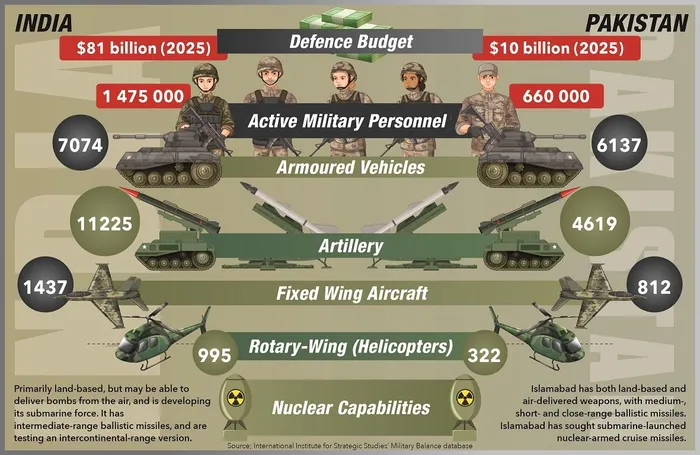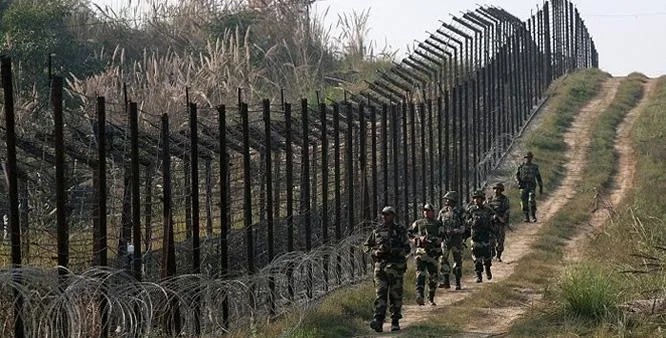
A map of Kashmir showing the line of control between India and Pakistan.
Image: Supplied
A deadly attack in the contested Kashmir region has prompted fears of spiralling conflict between nuclear-armed India and Pakistan.
New Delhi, which accuses Pakistan of backing the attack, has not yet taken military action. But Prime Minister Narendra Modi has given the Indian army "complete operational freedom" to respond. Pakistan, which denies responsibility, has vowed to retaliate against "any act of aggression".
The worst recent attack in Indian-run Kashmir was at Pulwama in 2019, when a suicide bomber rammed a car packed with explosives into a security forces convoy, killing 40 and wounding 35. Indian fighter jets carried out air strikes on Pakistani territory 12 days later.
Troops are now facing off along the 770-kilometre fortified Line of Control - the route of a ceasefire line dating back to 1949.

The comparative strength of the armies of India and Pakistan
Image: ACM Studio
India and Pakistan have fought over the Muslim-majority region since their partition at the end of British rule in 1947 while insurgents in Indian-run Kashmir have battled since 1989 seeking independence or a merger with Pakistan. Both countries trade accusations of arming groups in each other's territory to cause instability.
India, a Hindu majority nation with 1.4 billion people, and Pakistan, a Muslim-majority nation with 240 million citizens, both have nuclear weapons, and their militaries are among the largest in the world.
Pakistan's main weapons supplier is China, Islamabad's closest regional ally, as well getting drones from Turkey.
Although India's military strength is much larger, Pakistani analysts point to Islamabad's decades of experience fighting insurgencies on its border with Afghanistan.
India is the world's largest arms importer, according to the Stockholm International Peace Research Institute. The bulk of India's supplies come from Russia. New Delhi has also expanded military suppliers to include the United States, France and Israel, as well as developing its domestic production, including of aircraft carriers, submarines and helicopters.
Both sides have boosted their military capabilities since 2019.
Modi "showed he was capable of using force in 2019 and is now reaffirming that capability", said Melissa Levaillant of the European Council on Foreign Relations' Asia Programme.
He is also facing mounting public pressure at home to respond to the attack which has prompted a wave of anti-Pakistan sentiment

The Line of Control - the fortified border between India and Pakistan - has held for now.
Image: Supplied
"Many Indians demanded retribution against Pakistan," said Praveen Donthi, at the International Crisis Group. "Criticism of the Indian government's perceived failure to protect civilians was also widespread."
"But it's not clear exactly what the Indians want, particularly given that Pakistani support for terrorist groups has fallen sharply," Levaillant said.
The international community is also less likely to intervene than after previous spates of violence, like in 2019, analysts said.
"The US has a full plate with Ukraine, Gaza and the Iran deal, which may provide an opening to Beijing to insert itself into the crisis," said Colin Clarke, senior research fellow at The Soufan Center in New York.
"However, given China's close relationship with Pakistan, it is unlikely that China would be trusted as an objective interlocutor by India."
The United States would be even more likely to stay out of a possible conflict under the Trump administration, according to Levaillant. "Their relations with Pakistan have deteriorated and Islamabad is no longer a strategic asset in managing the Taliban in Afghanistan," she said.
Despite Modi's bellicose statements, it was unclear if New Delhi would retaliate against its neighbour, Donthi said.
"The ceasefire at the Line of Control, the de facto border between the Indian- and Pakistani-administered parts of Jammu and Kashmir, continues to hold for now," he said. "But New Delhi could still decide to strike, especially if it feels emboldened to do so by the expressions of support it has received from around the world."
Levaillant said both sides would be preparing for conflict, but that there were "still lots of unknowns" in the days-old crisis.
The Soufan Center's Clarke said: "Sometimes with conflicts, especially between longstanding adversaries, inertia takes over and leads to a fog of war which further ratchets up tensions and makes the situation considerably more dangerous."
The most dangerous outcome could be a spiral into armed conflict between two nuclear-armed countries, analysts said.
"The fact that there is any risk of escalation between two nuclear powers is among the most serious global security issues that can ever occur," warned Clarke.
The devastation from US atomic bomb attacks on Japan in 1945 led to a nuclear taboo that has since come under pressure, with Russian President Vladimir Putin repeatedly making nuclear threats since the start of the Ukraine war.
"This unrestrained global context shows that the nuclear red lines are shifting," Levaillant said.
Managing the escalation between India and Pakistan was "extremely risky, with a very vague Pakistani nuclear doctrine," she added.
But India could opt to "undermine this doctrine, show they can go and nibble away at a piece of territory" without Pakistan striking back.